Learn About the Process
Dietary Guidelines for Americans, 2025-2030 Development Process
Updating the Dietary Guidelines for Americans (Dietary Guidelines) is a scientifically rigorous, multi-year process. The U.S. Departments of Health and Human Services (HHS) and Agriculture (USDA) are committed to providing clear information to the public and providing opportunities for public participation during the process.
This is a 5-Step Process
-
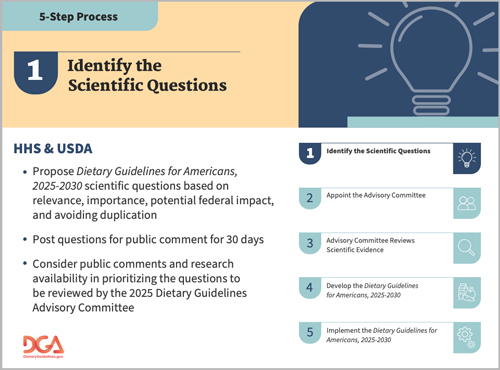
Step 1: Identify the Scientific Questions
During this step, HHS and USDA developed and asked for public comments on the proposed scientific questions. The questions inform the scientific review of the 2025 Dietary Guidelines Advisory Committee (Committee), ensuring that its work builds on the previous edition of the Dietary Guidelines and meets the needs of Federal nutrition policies and programs.
More information is provided below about how HHS and USDA identified the proposed scientific questions, the criteria used to develop each question, and the call for public comments that took place from April 15 – May 16, 2022.
Identifying the Proposed Scientific Questions
HHS and USDA conducted a yearlong process to gather information, receive input from Federal experts, and review relevant documents to develop the proposed scientific questions for public comment. The scientific questions inform the scope of the Committee’s evidence review and its scientific report. The questions focus on diet and health outcomes across the lifespan and examine the relationship between diet and the risk of overweight and obesity with a new emphasis on weight loss and weight maintenance and a question on ultra-processed foods. All scientific questions will be reviewed with a health equity lens to ensure that the next edition of the Dietary Guidelines is relevant to people with diverse racial, ethnic, socioeconomic, and cultural backgrounds. HHS and USDA will support the Committee to describe and consider factors such as socioeconomic status, race, ethnicity, and culture, to the greatest extent possible, based on the information provided in the scientific literature and data.
The proposed scientific questions were informed by the following:
- Scientific Report of the 2020 Dietary Guidelines Advisory Committee: Questions addressed by the 2020 Committee, particularly those that informed the development of the current Dietary Guidelines, and future directions documented in the Scientific Report of the 2020 Dietary Guidelines Advisory Committee.
- Topics of Public Health Interest: Consideration of current nutrition science and potential new topics of public health interest.
- Federal Review: Input from Federal nutrition scientists and program experts from across the Federal government, including the Interagency Committee on Human Nutrition Research (ICHNR) and other federal experts.
- Federal Resources: Consideration of existing Federal resources to avoid duplication of Federal efforts. Topics addressed by existing Federal resources were not included in the proposed scientific questions, although many will be included in the next edition of the Dietary Guidelines.
Alcohol and sustainability will be addressed in separate Federal processes. Learn more about how these topics are being addressed by visiting the Related Projects page.
Scientific Question Criteria
The criteria HHS and USDA used to prioritize the proposed scientific questions included the following:
- Relevance: Question is within the scope of the Dietary Guidelines and its focus on food-based recommendations, not clinical guidelines for medical treatment.
- Importance: Question addresses an area of substantial public health concern, uncertainty, and/or knowledge gap.
- Potential Impact to Federal Programs: There is a high probability that the question will provide the scientific foundation for guidance that would inform Federal food and nutrition policies and programs.
- Avoiding Duplication: The question is not addressed through existing or planned evidence-based Federal guidance (other than the Dietary Guidelines).
Research availability was evaluated for the proposed questions to determine whether sufficient evidence exists to conduct a new review or update an existing systematic review. If adequate research is not available, the question will be identified as an area needing more research.
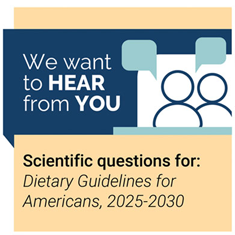
Public Engagement
HHS and USDA requested public comments, on the proposed scientific questions from April 15 – May 16, 2022. Approximately 1,400 public comments were received. About half of these submissions were identified as unique comments. View the public comments on the proposed scientific questions by visiting our page on Regulations.gov (Docket ID HHS-OASH-2022-0005).
HHS and USDA appreciate the public input and considered all comments in relation to the above criteria. The Departments will work with the Committee to refine and prioritize the questions as it initiates its evidence review.
Learn more about each step in the Dietary Guidelines development process by visiting our page on the topic:
-
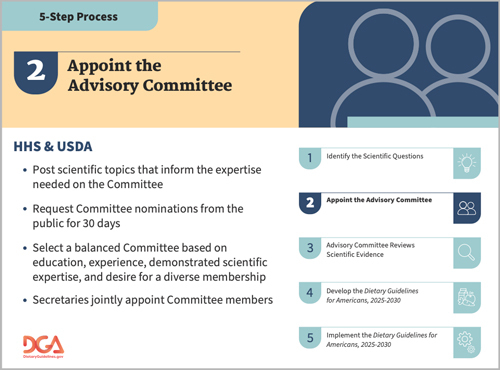
Step 2: Appoint the Advisory Committee
During this step, HHS and USDA requested nominations to the 2025 Dietary Guidelines Advisory Committee (Committee) and selected the Committee.
The call for nominations was held from June 15 – July 15, 2022. More information is provided below about how HHS and USDA established the Committee. Step 3 provides more information about the Committee’s evidence review.
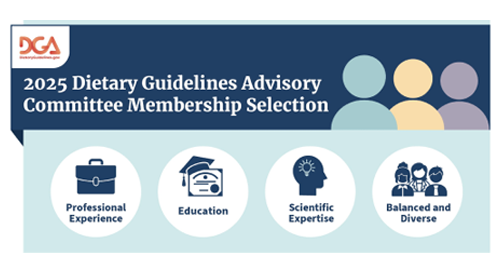
Establishing the Committee
The 2025 Dietary Guidelines Advisory Committee is formed under and governed by the Federal Advisory Committee Act (FACA), which provides legal requirements for forming and using Federal advisory committees. A charter is filed with Congress before the Federal advisory committee can meet or take any action. The Committee is charged with reviewing the evidence on nutrition and health across the lifespan. It will provide independent, science-based advice and recommendations to be considered by HHS and USDA.
Committee Selection
HHS and USDA accepted nominations from the public to serve on the 2025 Dietary Guidelines Advisory Committee. The Departments received nominations from individuals and organizations. To help support the goal of having a balanced and diverse committee, the Departments encouraged self-nominations and conducted outreach to make the public and stakeholders aware of the opportunity to provide nominations. HHS and USDA used the following evaluation criteria in the review of nominations:
- Professional Experience: At least ten years of experience as an academic, researcher, practitioner, or other health professional in a field related to one or more of the scientific topic areas to be examined; consideration of leadership experience and participation on previous expert committees or panels.
- Educational Background: Advanced degree in nutrition or health-related field, including registered dietitians, nutrition scientists, physicians, and those with public health degrees.
- Demonstrated Scientific Expertise: Expertise related to one or more of the scientific topic areas to be examined by the Committee as demonstrated by the number and quality of peer-reviewed publications and presentations. Expertise related to health equity and the scientific approaches used to review the evidence (systematic reviews with or without meta-analysis, food pattern modeling, and data analysis) is also desired.
- Balanced and Diverse Membership: A Committee that is reasonably balanced in terms of points of view and expertise, experience, education, and institutional affiliation, with a goal of establishing a diverse membership that is reflective of the racial, ethnic, gender, and geographic diversity within the United States.
Nomination Package Review
All complete nomination packages were reviewed by HHS and USDA program staff based on the factors listed above. Following review by program staff, nominees were evaluated by the HHS Assistant Secretary for Health and the USDA Deputy Under Secretary of Food, Nutrition, and Consumer Services.
Additional Review, Including Conflicts of Interest
The vetting process for potential members included a background check by HHS to determine if any candidates have a financial, ethical, legal, and/or criminal conflict of interest that would prohibit them from serving on the Committee. In addition, HHS ethics officials ensured interests and affiliations of proposed Committee members complied with applicable conflict of interest statutes, regulations issued by the U.S. Office of Government Ethics (OGE), additional agency requirements, and other applicable Federal ethics rules. Each Committee member submitted a confidential financial disclosure report and will continue to submit one annually until the Committee concludes. HHS ethics officials review each report for financial conflicts of interest and compliance with Federal ethics rules. Following the review process, the member recommendations were submitted to the Secretaries of HHS and USDA for approval.
HHS and USDA Secretary Review and Appointment
The Secretaries of HHS and USDA reviewed formal nomination recommendations from the departments on the proposed Committee members and jointly appointed individuals to serve on the Committee. Committee members are appointed as Special Government Employees (SGEs) and are subject to applicable Federal ethics rules. Each Committee member receives ethics training upon appointment and annually throughout their service on the Committee. Committee members are not paid for their service, although travel expenses are reimbursed.
Following appointment, the Committee begins its work to review the scientific evidence on nutrition and health across the lifespan.
Learn more about each step in the Dietary Guidelines development process by visiting our page on the topic:
-
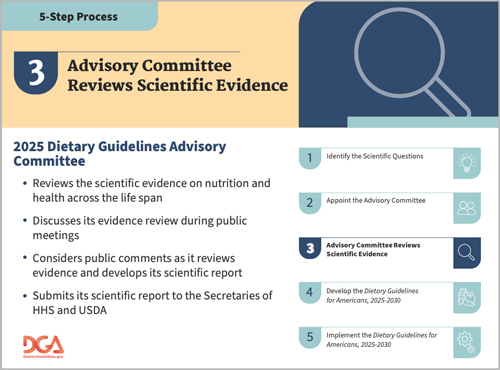
Step 3: Advisory Committee Reviews Scientific Evidence
The 2025 Dietary Guidelines Advisory Committee (Committee) began its review of scientific evidence on nutrition and health from birth through older adulthood at its first meeting. Throughout the Committee’s work, the public is encouraged to participate in public meetings and provide comments.
More information is provided below about the Committee’s work, its review of the evidence, and the scientific approaches.
The Role of the Committee
Committee members collaborate to develop evidence review protocols, review and synthesize evidence, present scientific findings, and consider public comments. The Committee’s work culminates in a comprehensive scientific report on the current state of nutrition science and provides independent recommendations to HHS and USDA. The Committee reviews evidence from early 2023 until late 2024. It will meet approximately six times, and all Committee meetings will be open to the public virtually. The activities of the Committee will conclude upon delivery of its scientific report to the Secretaries or when its two-year charter expires, whichever comes first.
The Committee’s Evidence Review
The Committee is examining the evidence from a list of prioritized scientific questions, informed by the proposed list of scientific questions identified by HHS and USDA. The list of prioritized questions is available on the Scientific Questions page. The scientific questions are organized by subcommittees and the approach used to evaluate each question.
Scientific Approaches
The Committee is using three approaches to examine the evidence: Nutrition Evidence Systematic Review (NESR) systematic reviews, food pattern modeling, and data analysis. Each of these approaches has its own rigorous, protocol-driven methodology, and plays a unique, complementary role in examining the science. For each approach, staff from HHS and USDA will support the Committee's review of the evidence. The Examine the Evidence page provides more information about each of these approaches.
Scientific Report
The Committee will develop a scientific report that will be submitted to the Secretaries of HHS and USDA. The Committee’s report provides the review of the current state of nutrition science and includes independent, evidence-based advice for HHS and USDA to consider as the Departments develop the next edition of the Dietary Guidelines. Upon delivery of its report to the Secretaries or when its 2-year charter expires, whichever comes first, the activities of the Committee will be completed, and the Departments will develop the Dietary Guidelines for Americans, 2025-2030, informed by the work of the Committee, Federal agency input, and public comments. HHS and USDA plan to release the Dietary Guidelines by the end of 2025.
Get Involved
Participate in the process by providing public comments to the Committee and attending Committee meetings virtually. Information about upcoming meetings and how to provide public comments can be found on the Get Involved page. Sign up to receive email updates on the Dietary Guidelines development process and other related news, including opportunities for public involvement.
Find out more about each step in the Dietary Guidelines development process by visiting our page on the topic:
-
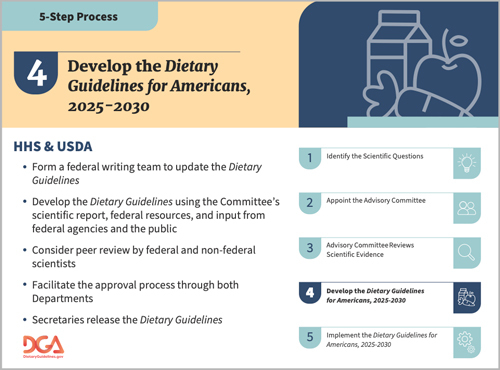
Step 4: Develop the Dietary Guidelines
During this step, HHS and USDA work together to develop the Dietary Guidelines. Each edition of the Dietary Guidelines builds upon the preceding edition, with the scientific justification for revisions informed by the scientific report of the 2025 Dietary Guidelines Advisory Committee (scientific report) and consideration of public and Federal agency comments.
The scientific report is a resource that helps to inform HHS and USDA’s development of the Dietary Guidelines – it is not a draft of the Dietary Guidelines. View our infographic to learn more about the differences between the scientific report and the Dietary Guidelines.
To learn more about the Dietary Guidelines development process, visit our page on this topic.
Learn more about each step in the Dietary Guidelines development process by visiting our page on the topic:
-
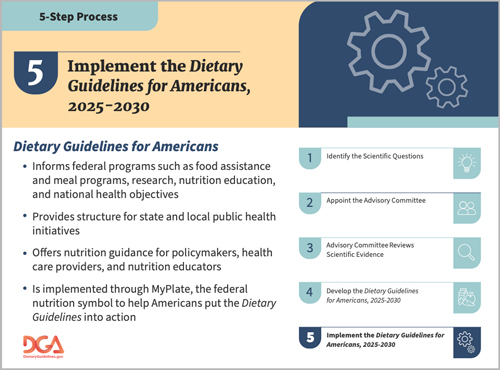
Step 5: Implement the Dietary Guidelines
During this step, HHS and USDA release the updated Dietary Guidelines and work with Federal, state, and local partners to implement the new edition.
The Dietary Guidelines provide advice on dietary patterns to help meet nutrient needs, promote health, and prevent disease. It provides a customizable framework for healthy eating that can be tailored and adapted to meet personal preferences, cultural traditions, and budgetary considerations. It is developed and written for a professional audience, including policymakers, healthcare providers, nutrition educators, and Federal nutrition program operators. These audiences all rely on the Dietary Guidelines when providing information on diet and health to the general public. For example, the recommendations in the Dietary Guidelines inform nutrition standards for the Special Supplemental Nutrition Program for Women, Infants, and Children and the Older Americans Act Nutrition Programs.
While the process to develop the next edition of the Dietary Guidelines is under way, work is ongoing to support implementation of the current edition of the Dietary Guidelines to help promote health and reduce risk of disease among Americans. A suite of resources is available in both English and Spanish in the current Dietary Guidelines section to support implementation efforts. These resources include print materials, brochures, and infographics to share directly with patients and clients and supporting materials, such as presentation slides and figures that can be used in a professional setting and adapted to support specific outreach efforts.
Another way to implement the Dietary Guidelines is through MyPlate, which serves as a reminder to build healthy eating patterns by making healthy choices across the food groups. Both Federal and nonfederal programs use MyPlate as a resource to help Americans make shifts in their daily food and beverage choices to align with the Dietary Guidelines.
Learn more about each step in the Dietary Guidelines development process by visiting our page on the topic:
